 You were born in Penang. On festive days, you wear Nyonya clothes. You eat Nyonya food brought to you in a Nyonya tiffin carrier, in a Nyonya porcelain bowl. You speak Penang Hokkien to your mother and father. Does that make you Baba Nyonya?
You were born in Penang. On festive days, you wear Nyonya clothes. You eat Nyonya food brought to you in a Nyonya tiffin carrier, in a Nyonya porcelain bowl. You speak Penang Hokkien to your mother and father. Does that make you Baba Nyonya?In this age where there is once again a renewed interest in our heritage, I visit this topic to provide a clear explanation of what being Baba Nyonya is about. Today many people claim that they are Penang Baba Nyonya. However, the truth is almost everybody in Penang is Sinkheh - that's what the Baba Nyonyas call the muggles, people who are not Baba Nyonya.
(For the purpose of this article, the term "Baba Nyonya" is used for Straits-born Chinese people of Penang (and the northern Malay peninsula), while "Peranakan" for those of Malacca, Singapore and the southern Malay peninsula.)
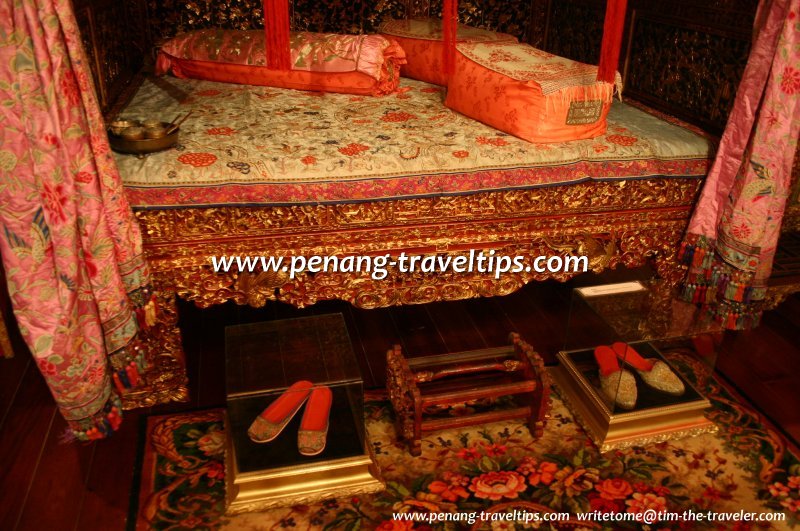 Nyonya bedchamber, (21 August 2004)
Nyonya bedchamber, (21 August 2004)
To be true-blood Penang Baba Nyonya requires more than the ability to speak Penang Hokkien, or cook Nyonya food or wear Nyonya clothes. Or own Nyonya porcelain and furniture. It's in the blood, a pedigree thing.
I was born in Penang. My mother is Hokkien. We are English educated. My maternal grandmother wears Nyonya clothes. I grew up reciting Hokkien ditties. I learn everything there is to understand about being Baba Nyonya, and to my chagrin, I learn that I don't qualify.
To be Baba Nyonya, mother tongue doesn't count. Father tongue does. My father, however, is Sinleng, a subgroup of Cantonese. You cannot be Baba Nyonya if you are Cantonese1, even if you're born in Penang. There's no such thing as a Cantonese Baba Nyonya. Same goes if you're Hakka, or Hainanese. You have to be Hokkien, or at least, Teochew. So, I'm out.
So what does it take to be a purebred Baba Nyonya? It helps if both your parents are Hokkien. It helps if your parent and grandparents were English educated. But to clear all doubts that you are purebred Baba Nyonya, you have to be able to provide a family tree showing that your ancestors arrive in this part of the world, the Nanyang, before wide-scale tin mining began. Who are the Baba Nyonya? They were the Hokkien seafarers who arrived and settled in this part of the world in the 15th, 16th and 17th centuries. They left China for economic as well as political reasons. Many of them may have been involved in rebellion against the Manchu government, which they did not consider a legitimate government over them. So when the Manchus moved to crush the rebellion in southern China, they fled to various parts of the Nanyang.
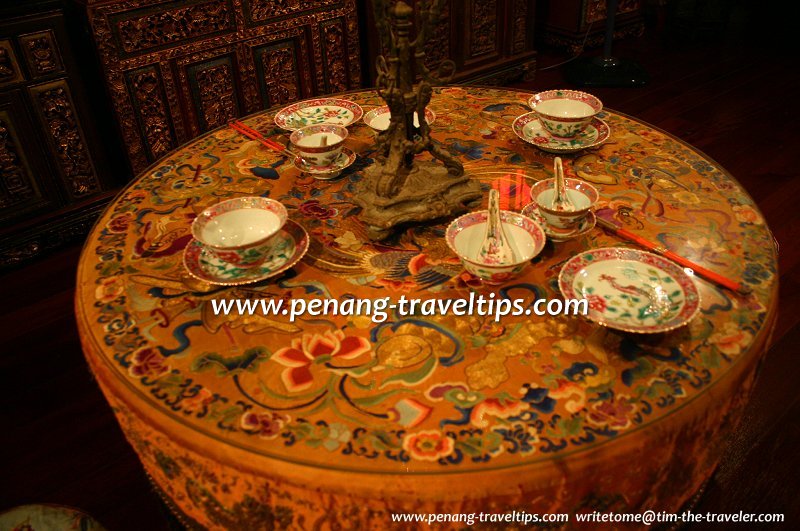 Nyonya porcelain, (21 August 2004)
Nyonya porcelain, (21 August 2004)
Their arrival in this region predates the arrival of Francis Light and the founding of George Town as a British trading port. They lived in coastal villages in northern peninsular Malaya (a separate group of Hokkien seafarers settled the southern coast and become the Peranakan, but that's a different story for another day) until the founding of George Town, when a good number moved to live in Penang.
The forefathers of the Baba Nyonyas had no motivation to return to China. By settling in the Nanyang, they have severed their ties with their Chinese homeland. Although they continue to speak Hokkien and profess a Taoist faith, they have also absorbed local folk beliefs and customs. Their vocabulary includes many loan words borrowed from Malay, among them ja1li4 (finger), jam1ban2 (toilet) and ma1ta1 (policeman).
The Baba Nyonya make offerings to the earth spirit, or Dato Kong, a practise that is absent in their China homeland. They make offering of nasi kunyit (turmeric-coloured rice) and chicken curry to the Dato Kong if their newborn infant survives past a full month.
When the British established Penang, the Baba Nyonyas sent their children to be educated in English schools. As a result, many became Anglophiles, preferring to look West than to look East (and there is nothing pleasant to look East about, as they regarded the Qing Dynasty government as unredeemably corrupt.)
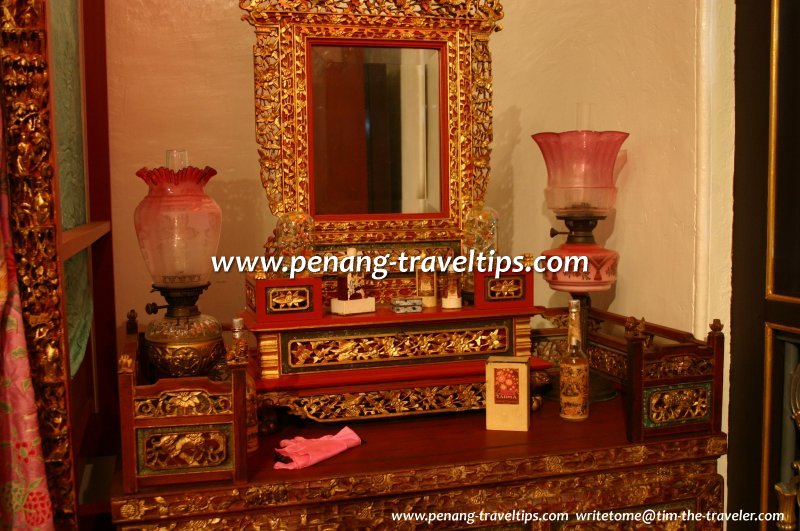 Nyonya vanity table, (21 August 2004)
Nyonya vanity table, (21 August 2004)
So it was from 1786 until the 1860's, that the Baba Nyonya set the rules of what Chinese language to be spoken in Penang. During that period, Mandarin was hardly ever use, except when having to deal with the Qing Dynasty officials. Just as the British had to deal with the Malay menteris, or officials, they used that same word, inherited from the Portuguese, to refer to those same Imperial bureaucrats of China. Hence the name "Mandarin" come about. (By the way, the word Menteri itself comes from the Sanskrit mantrin and is related to the word mantra.)
The Baba Nyonyas were never numerous. But their influence far outweighs their numbers. They established Hokkien as the lingua franca in this part of the peninsula. When tin mining took off in the Larut Valley, they were the early financiers. In so doing, they established Hokkien as the spoken language in Taiping.
While the mid-19th century was the dawn of prosperity in Penang, it coincided with a period of economic and political turmoil in China. The Taiping Rebellion (1850-1864) swept through southern China. One of the deadliest military conflicts in history, it claimed some 20 million lives and brought undue hardship to those living in the southern provinces. This caused an influx of Chinese immigrants to Malaya. Many arrived penniless to work the mines.
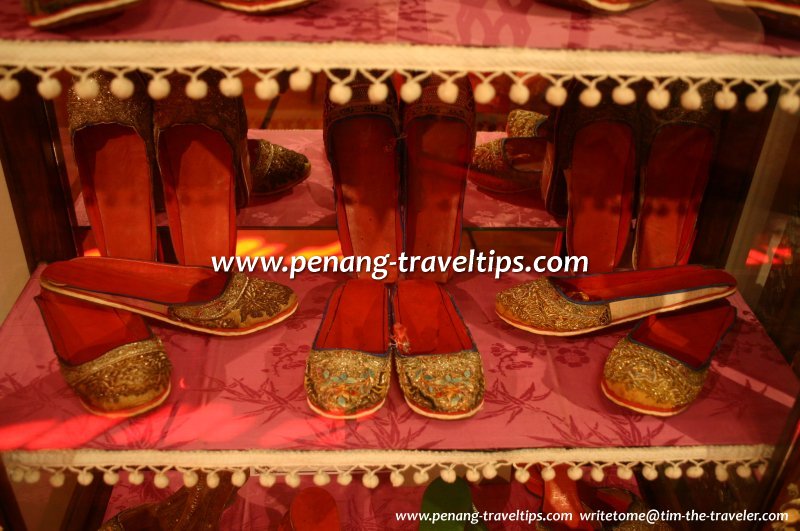 Nyonya beaded slippers, (21 August 2004)
Nyonya beaded slippers, (21 August 2004)
Unlike the early settlers, the newcomers were not only Hokkien, but also Cantonese and Hakka. Later on, other groups such as the Hainanese also arrived. The Cantonese established themselves in the mining townships such as Ipoh, Kuala Lumpur and Seremban. These cities, located away from the coast, would not have been established without tin mining. In comparison, all the towns along the peninsular where Hokkien predominates (excepting Taiping) were coastal, because they came into being before large-scale tin mining took hold.
The newcomers also spilled into George Town. The Baba Nyonyas call these newcomers Sinkheh, meaning "new guests", while they refer to themselves as "pun teh lang" (locals). The same term "pun teh lang" is used way back in 17th century China, when the Hokkiens there refer to another group of migrants to the Fujian province, the Hakkas, whom they call "Khek lang" (literally "guests").
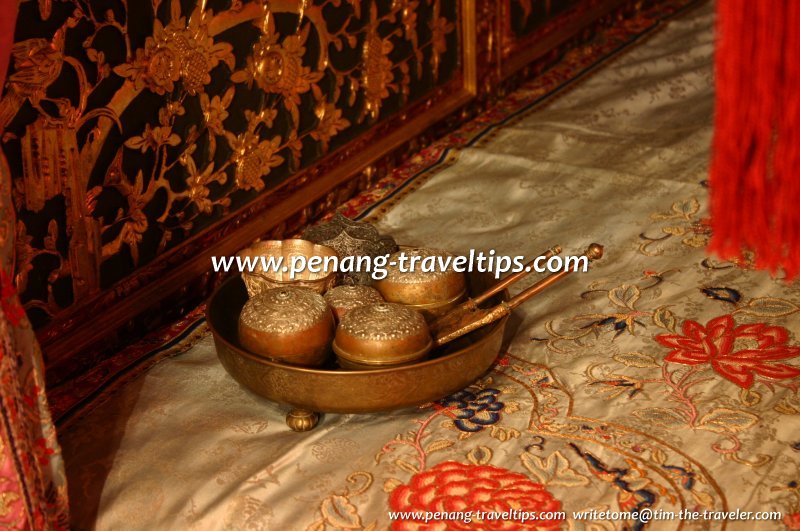 Nyonya betel nut tray, (21 August 2004)
Nyonya betel nut tray, (21 August 2004)
The Sinkheh, be they Hokkien, Cantonese or Hakka, quickly overwhelm the small existing Hokkien population. To differentiate between the two groups, the British came up with the term Straits Chinese or Straits-born Chinese, as the majority of the early Hokkiens were already staying in the Straits Settlements, whereas the newcomers populated the newly established tin-mining towns. However the term Straits-born creates a gross distortion in our understanding of the Baba Nyonya.
Firstly, it breeds assumption that as long as a person is born in any of the Straits Settlements, he or she qualifies to be a Baba Nyonya. Secondly, although the term Straits Chinese is intended to differentiate between the "oldtimers" and "newcomers", it fails to mention that offsprings of the newcomers cannot be regarded as Baba Nyonya, even if they were born in the Straits Settlements, as they are not of Baba Nyonya ancestry. Thirdly, the Baba Nyonya has been around even before the Straits Settlements were founded; although most of them lived in the Straits Settlements, they were already also living in small coastal settlements such as Prai and Kuala Kedah before Penang was established. And finally, the term Straits Chinese is applied as a catch-all without regard to the differences between the Baba Nyonya of Penang and those of Malacca and Singapore. Despite their similarities, they come from separate branches.
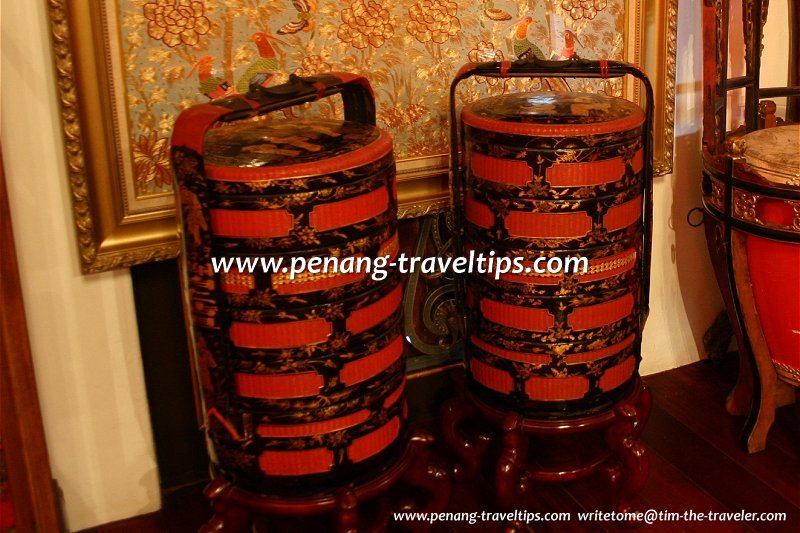 Sianah, the Nyonya ceremonial baskets (21 August 2004)
Sianah, the Nyonya ceremonial baskets (21 August 2004)
The Baba Nyonyas were wealthy and influential in the 19th century. Having survived on their wits for centuries, they easily tapped the potential from tin mining. The newfound wealth translated into a flourishing of their culture. They enjoy the best of both worlds, building European-style homes complete with faux-European names, while continuing to practise their own brand of culture. Their townhouses brought a fusion of Eastern and Western elements, creating what is now known as the Straits Eclectic style. They commission porcelain-ware from China, often according to their own specifications.
Unlike the Baba Nyonyas, with no ties to a China homeland, the Sinkhehs expected to make a fortune and return home. So there is a difference in mindset between the two groups. Looking West, the Baba Nyonyas sent their children to English schools, while the Sinkhehs start establishing schools with Chinese as the medium of instruction. In the beginning, these schools taught in Hokkien and other Chinese languages, but after the Xinhai Revolution of 1911, and the fall of the Qing Dynasty government, the different groups of Chinese became more accepting of Mandarin as the medium of instruction.
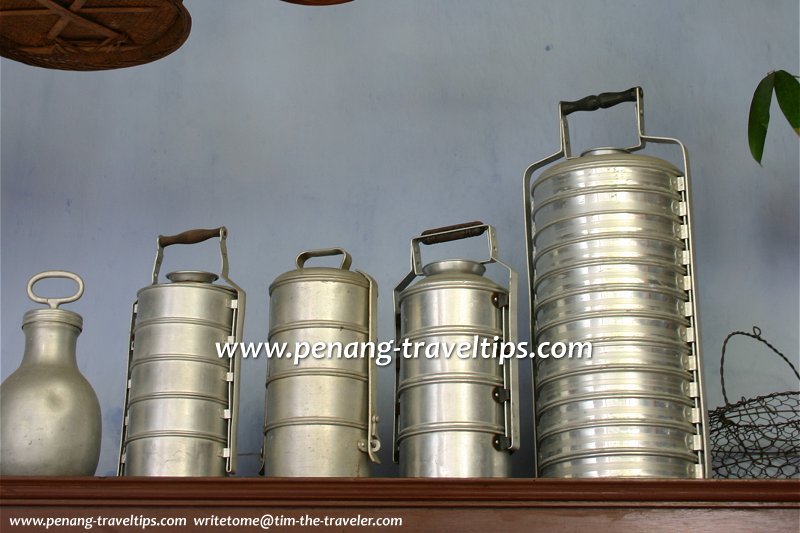 Nyonya tiffin carriers (4 February 2006)
Nyonya tiffin carriers (4 February 2006)
The use of Mandarin has eroded the position of the Baba Nyonyas, who clung to English until the late 1970s, when English-medium schools were nationalised, and Bahasa Malaysia became the medium of instruction in those schools. It brought about a homogeny among the local Chinese, in that regardless whether they were Hokkien or Cantonese, Baba Nyonya or Sinkheh, today the majority send their children to schools where the medium of instruction is Mandarin. This wholesale embrace of Mandarin is accompanied by an erosion in knowledge and comprehension of one's own heritage, particularly the Baba Nyonya heritage, so much so that today, anybody could claim to be Baba Nyonya based solely on his lifestyle, his ability to produce Nyonya dishes, recite Nyonya nursery rhymes, or use Nyonya furniture.
The years of neglecting the Baba Nyonya heritage has resulted in many having forgotten their ancestry. Moreover, when a Baba Nyonya marries a Sinkheh, unless the person maintains his family tree, he would have become a Sinkheh. As it is very difficult to find those who are able to prove their Baba Nyonya ancestry, most of the Chinese people in Penang are really Sinkheh maintaining Baba Nyonya culture.
Notes
1 Wikipedia's entry on Peranakan (https://en.wikipedia.org/wiki/Peranakan) mentions that the Peranakan can be of Cantonese descent. This therefore contradicts my understanding that the Peranakan is confined to only Hokkien and Teochew descents. Of course, we can't take everything we read in Wikipedia is accurate, but it does open up the issue to further research.Further Reading
- Mandarin, in Wikipedia
Bibliography
- Chinese Overseas: Comparative Cultural Issues, by Chee Beng Tan, Hong Kong University Press
- A Nyonya Mosaic: Memoirs of a Peranakan Childhood, by William Gwee, Marshall Cavendish International Asia, page 12
Private Guided Tours of Penang
If you are seeking private guided tours of Penang, message Penang Tour Guides at penangtourguides@gmail.com and enquire with them. Buy, rent or sell properties in Penang
Buy, rent or sell properties in Penang
Do you have a property for sale or to rent out? Are you looking to buy or rent a property? Get in touch with me. WhatsApp me (Timothy Tye) at 012 429 9844, and I will assign one of my property agents to serve you. I will choose the agent for you, according to your property needs. So when you message me, provide me some details of what you need, whether to sell, to buy, to rent or to rent out, and what type of property, is it condo, apartment, house, shop, office or land. Latest updates on Penang Travel Tips
Latest updates on Penang Travel Tips
 Map of Roads in Penang
Map of Roads in Penang
Looking for information on Penang? Use this Map of Roads in Penang to zoom in on information about Penang, brought to you road by road.About this website

Dear visitor, thank you so much for reading this page. My name is Timothy Tye and my hobby is to find out about places, write about them and share the information with you on this website. I have been writing this site since 5 January 2003. Originally (from 2003 until 2009, the site was called AsiaExplorers. I changed the name to Penang Travel Tips in 2009, even though I describe more than just Penang but everywhere I go (I often need to tell people that "Penang Travel Tips" is not just information about Penang, but information written in Penang), especially places in Malaysia and Singapore, and in all the years since 2003, I have described over 20,000 places.
While I try my best to provide you information as accurate as I can get it to be, I do apologize for any errors and for outdated information which I am unaware. Nevertheless, I hope that what I have described here will be useful to you.
To get to know me better, do follow me on Facebook!
Copyright © 2003-2025 Timothy Tye. All Rights Reserved.

 Go Back
Go Back